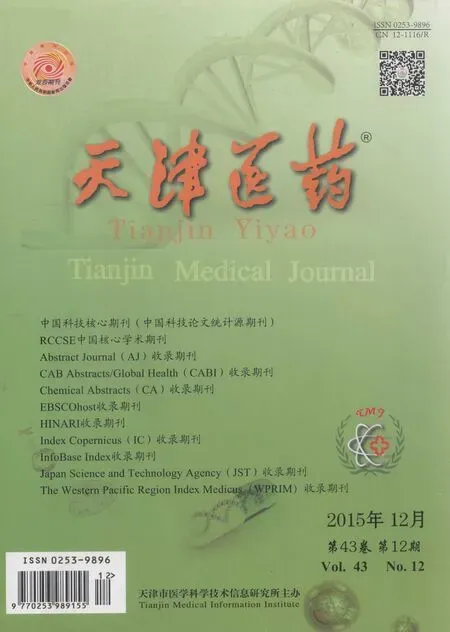Sox2在胶质母细胞瘤中的研究进展
郭金满,谭超,胡火军,谭园
Sox2在胶质母细胞瘤中的研究进展
郭金满,谭超△,胡火军,谭园
胶质母细胞瘤(GBM)属于世界卫生组织(WHO)Ⅳ级恶性肿瘤,是除脑干胶质瘤外预后较差的中枢神经系统癌症,发病率占人原发性恶性脑肿瘤的80%,患者5年生存率仅有5%。Sox2是一种多能性调节子,越来越多的证据表明,Sox2的突变及其功能异常与GBM的发生密切相关。已有研究证实利用Sox2基因作为GBM治疗靶点具可行性。本文在此将Sox2在GBM中的新研究进展进行综述。
胶质母细胞瘤;中枢神经系统肿瘤;基因疗法;综述;Sox2
Sox基因家族是一类SRY(Sex determination region of Y chromosome)相关基因构成的基因家族,编码一系列SOX(SRY-related high-mobility-group box)家族的转录因子,其产物都具有一个HMB(high-mobility-group box)集序保守结构域,目前研究者已从不同进化程度的生物中鉴定出了30多个成员[1]。Sox基因是机体性别决定、软骨形成、血细胞生成、神经嵴发育及神经再生的重要发育调控子[2]。研究显示,在中枢神经系统发育的早期,Sox2表达于神经上皮细胞中[3]。神经系统发育成熟之后,Sox2表达仅局限于胚基的神经胶质干细胞[4];但当神经胶质细胞恶变后,Sox2在脑胶质瘤中被激活而重新表达,且表达量显著高于正常组织[5]。本文将Sox2在胶质母细胞瘤中的新研究进展进行综述,为进一步深入研究提供参考。
1 胶质母细胞瘤(GBM)
中枢神经系统肿瘤包括脑肿瘤、脊髓肿瘤和神经根肿瘤,发病率约占肿瘤总数的3%,但死亡率却占癌症致死的7%[6]。全球每年约有350 000人被确诊为大脑胶质瘤,其已成为最常见的原发性脑肿瘤。2000年,世界卫生组织(WTO)根据胶质瘤的组织起源将其分为4大类:星形细胞瘤(astrocytoma)、少突胶质细胞瘤(oligodendroglioma)、室管膜瘤(ependymoma)及混合型少突星形细胞瘤(mixed oligoastrocytoma)[7]。其中,星形细胞瘤是具有星形胶质细胞分化特点的肿瘤,其与由星形胶质细胞衍化来的GBM是最常见的中枢神经系统肿瘤,约占神经上皮组织肿瘤的61%[8]。GBM属于WHOⅣ级恶性肿瘤,是星形细胞瘤中恶性程度最高的胶质瘤,发病率占人原发性恶性脑肿瘤的80%[9]。胶质母细胞瘤是人最致命的癌症之一,每年每十万人中新增发病人数5~20例,平均生存期仅为14个月[10]。GBM位于皮质下,常侵犯脑叶及深部结构,还可波及对侧大脑半球,其典型的表征是细胞进入凋亡程序出现障碍,基因组不稳定和对治疗手段应答低下,因而呈现浸润性生长和复发[11]。GBM内还存在坏死区,内部血管生长紧密并具有高侵袭性。目前,研究者们对GBM的基因组[12]和转录组[13]进行了大量研究。但迄今为止,临床仍无可治愈GBM的特效药[14]。
2 Sox2与GBM
2.1 Sox2在GBM中的作用研究发现,Sox2在多种肿瘤中表现为高表达,包括GBM,且Sox2的高表达往往与GBM患者治疗后效果欠佳密切相关[15]。鉴于Sox2在GBM中的异常
表达,因此Sox2被认为是胚胎干细胞与神经干细胞至关重要的转录调节子[16]。
Gangemi等[17]研究发现,人体来源的胶质瘤干细胞(glioma stem cells,GSCs)富含Sox2,它在维持GSCs的干细胞特性及致瘤性中起重要作用,如siRNA介导的GSCs中Sox2表达的下调,可显著降低其在体内增殖及形成肿瘤的能力;Sox2通过作用于与正常的神经干细胞相同的分子靶点来维持GSCs的干细胞特性,其还是GBM一个分层调控模型的关键分子,这为进一步找寻下游基因作为治疗靶点开辟了新的途径。此外,Ikushima等[18]研究发现,虽然提高Sox2的表达对GSCs至关重要,但却不足以维持GSCs的自我更新能力,这表明激活GSCs的干细胞样特性还需要其他因子的协同作用。Suvà等[19]研究证实,包括Pou3f2、Sox2、Sall2、Olig2在内的一组神经发育核心转录因子(transcription factors,TFs)对GBM的增殖至关重要。这些转录因子结合并活化特异性干细胞样肿瘤增殖细胞(tumor propagating cells,TPCs)调控元件后,足以将已分化的GBM细胞重新编程为“诱导的”TPCs,重现表观遗传学背景及TPCs的原始表型。此外,Sox2还可驱动更多的癌症相关表型,且Sox2驱动的恶性GBM具有高度的侵袭性及迁移性,这与神经干细胞极其相似[20]。事实上,Oppel等[21]证实,Sox2损耗造成的GBM细胞增殖能力的降低是由Cyclin D1水平的降低而引起的,而GBM侵袭性活动能力的降低是通过抑制黏着斑激酶(focal adhesion kinase,FAK)信号,如HEF1/NEDD9的下游蛋白及基质金属蛋白酶1/2来实现的[22]。
2.2 Sox2在GBM中的激活机制Alonso等[23]证实,GBM患者体内Sox2的扩增及启动子DNA低甲基化是导致Sox2异常表达的主导机制。Mikkelsen等[24]研究发现,Sox2以高CpG浓度的形式遍布整个启动子区,且可能抑制了基因分化,这表明在GBM中的Sox2启动子DNA的低甲基化可能反映了一种更原始的细胞状态,这与在神经干细胞中的发现相类似。此外,Ikushima等[25]研究证实,Sox2也可在转录水平上进行调节,且在GBM形成相关的下游途径中发挥作用。转化生长因子(TGF)-β通过Sox2来调控GBM生长;而血小板源性生长因子(PDGF)也可调节Sox2的活性。事实上,神经祖细胞的PDGF转化活性及小鼠PDGF依赖性肿瘤均会导致Sox2的表达[26]。在人GSCs中,siRNA介导的Sox2表达下调有助于提高PDGF及胰岛素样生长因子(IGF)受体抑制剂的敏感性[27],表明了PDGF及IGF-1受体抑制剂在GBM中的抗性与Sox2的表达密切相关。另外,Ge等[28]研究发现,Sox2是由真核起始因子4E(eIF4E)在翻译水平上激活的;GBM患者组织标本显示,Sox2和eIF4E表达呈正相关,且eIF4E表达的下调显著降低了Sox2的蛋白水平,但同时并不改变其在GSCs中的信使RNA(mRNA)水平。此外,大量研究表明,不同的微小核糖核酸(miRNAs),包括miR-9、miR-145、miR-21、miR-137在转录后水平均调控着GSCs的表达,并可通过传递化学抗性来调控Sox2的活性[29]。
Fang等[30]通过微阵列分析识别Sox2的下游靶点时发现,489个基因及105个前体miRNAs在Sox2基因沉默时表达量发生了改变。其中,在已确认的相关靶点中,肿瘤抑制因子BEX1/2及miR-143/145/253-5p/45在Sox2沉默时表达显著下调;同时,Sox2可与miR-145形成一个双负反馈环路。miR-145可沉默多个包括Sox2在内的多能性决定因子[31]。因而笔者推测,可能有一个专属的机制来维持2种功能之间的平衡,但这还有待进一步的研究。Basu-Roy等[32]最新的研究表明,骨肉瘤细胞需要Sox2阻碍Hippo信号途径以维持其干细胞特性。Favaro等[33]研究发现,移植了Sox2缺失突变细胞的小鼠无肿瘤生成,而对照组却生成了致死性的肿瘤;若在移植了Sox2缺失突变细胞的小鼠中导入一个Sox2基因表达病毒,就会导致肿瘤的形成。此外,Favaro等[34]还证实,若给小鼠免疫接种Sox2肽,可显著推迟肿瘤产生的时间,突显了利用Sox2基因作为治疗靶点的可行性。
3 展望
综上所述,GBM是死亡率最高和最常见的一种脑癌,是一种严重危害人类健康的恶性肿瘤。Sox2是多能性调节子,可能在转录及染色质的重塑过程中通过与酵母交换型转换/蔗糖不发酵(swi/snf)复合物、Mi-2/核小体重组和脱乙酰基酶(NURD)复合物等结合发挥多种作用。利用Sox2基因作为GBM治疗靶点具有可行性,可进一步利用如RNA深度测序、RNA纯化的染色质分离技术(ChIRP)、RNA免疫共沉淀测序(RIP-seq)等技术进行深入研究,破译出Sox2参与的GBM形成通路中的具体机制,为设计合理的治疗方案提供参考。
[1]Zhang J,Jiang H,Shao J,et al.Sox4 inhibits GBM cell growth and induces G0/G1 cell cycle arrest through Akt-p53 axis[J].BMC Neurol,2014,14(1):207.doi:10.1186/s12883-014-0207-y.
[2]Kamachi Y,Kondoh H.Sox proteins:regulators of cell fate specification and differentiation[J].Development,2013,140(20):4129-4144. doi:10.1242/dev.091793.
[3]Liu YR,Laghari ZA,Novoa CA,et al.Sox2 acts as a transcriptional repressor in neural stem cells[J].BMC Neurosci,2014,15:95.doi: 10.1186/1471-2202-15-95.
[4]Arnold K,Sarkar A,Yram MA,et al.Sox2(+)adult stem and progenitor cells are important for tissue regeneration and survival of mice[J].Cell Stem Cell,2011,9:317-329.doi:10.1016/j.stem.2011.09.001.
[5]Louis DN,Ohgaki H,Wiestler OD,et al.The 2007 WHO classification of tumors of the central nervous system[J].Acta Neuropathol,2007,114:97-109.
[6]Crocetti E,Trama A,Stiller C,et al.Epidemiology of glial and nonglial brain tumors in Europe[J].Eur J Cancer,2012,48:1532-1542. doi:10.1016/j.ejca.2011.12.013.
[7]Fuentes-Raspall R,Vilardell L,Perez-Bueno F,et al.Populationbased incidence and survival of central nervous system(CNS)malignancies in Girona(Spain)1994-2005[J].J Neurooncol,2011,101(1): 117-123.doi:10.1007/s11060-010-0240-7.
[8]Tanaka S,Louis DN,Curry WT,et al.Diagnostic and therapeutic avenues for glioblastoma:no longer a dead end[J]?Nat Rev Clin Oncol,2013,10:14-26.doi:10.1038/nrclinonc.2012.204.
[9]Clarke J,Butowski N,Chang S.Recent advances in therapy for glio-
[10]Brennan CW,Verhaak RG,McKenna A,et al.The somatic genomic landscape of glioblastoma[J].Cell,2013,155(2):462-477.doi: 10.1016/j.cell.2013.09.034.
[11]Frattini V,Trifonov V,Chan JM,et al.The integrated landscape of driver genomic alterations in glioblastoma[J].Nat Genet,2013,45(10): 1141-1149.doi:10.1038/ng.2734.
[12]Verhaak RG,Hoadley KA,Purdom E,et al.Integrated genomic analysis identifies clinically relevant subtypes of glioblastoma characterized by abnormalities in PDGFRA,IDH1,EGFR,and NF1[J]. Cancer Cell,2010,17(1):98-110.doi:10.1016/j.ccr.2009.12.020.
[13]Dunn GP,Rinne ML,Wykosky J,et al.Emerging insights into the molecular and cellular basis of glioblastoma[J].Genes Dev,2012,26(8):756-784.doi:10.1101/gad.187922.112.
[14]Annovazzi L,Mellai M,Caldera V,et al.SOX2 expression and amplification in gliomas and glioma cell lines[J].Cancer Genomics Proteomics,2011,8(3):139-147.
[15]Schwede M,Spentzos D,Bentink S,et al.Stem cell-like gene expression in ovarian cancer predicts type II subtype and prognosis[J]. PLoS One,2013,8(3):e57799.doi:10.1371/journal.pone.0057799.
[16]Holmberg J,He X,Peredo I,et al.Activation of neural and pluripotent stem cell signatures correlates with increased malignancy in human glioma[J].PLoS One,2011,6(3):e18454.doi:10.1371/journal. pone.0018454.
[17]Gangemi RM,Griffero F,Marubbi D,et al.SOX2 silencing in glioblastoma tumor-initiating cells causes stop of proliferation and loss of tumorigenicity[J].Stem Cells,2009,27(1):40-48.doi:10.1634/ stemcells.2008-0493.
[18]Ikushima H,Todo T,Ino Y,et al.Glioma-initiating cells retain their tumorigenicity through integration of the Sox axis and Oct4 protein[J].J Biol Chem,2011,286(48):41434-41441.doi:10.1074/ jbc.M111.300863.
[19]Suvà ML,Rheinbay E,Gillespie SM,et al.Reconstructing and Reprogramming the Tumor-Propagating Potential of Glioblastoma Stem-like Cells[J].Cell,2014,157(3):580-594.doi:10.1016/j. cell.2014.02.030
[20]Lalli G.Extracellular signals controlling neuroblast migration in the postnatal brain[J].Adv Exp Med Biol,2014,800:149-180.doi: 10.1007/978-94-007-7687-6_9.
[21]Oppel F,Müller N,Schackert G,et al.SOX2-RNAi attenuates S-phase entry and induces RhoA-dependent switch to protease-independent amoeboid migration in human glioma cells[J].Mol Cancer,2011,10:137.doi:10.1186/1476-4598-10-137.
[22]Chen T,Dent SY.Chromatin modifiers and remodellers:regulators of cellular differentiation[J].Nat Rev Genet,2014,15(2):93-106. doi:10.1038/nrg3607.
[23]Alonso MM,Diez-Valle R,Manterola L,et al.Genetic and epigenetic modifications of Sox2 contribute to the invasive phenotype of malignant gliomas[J].PLoS One,2011,6:e2674.doi:10.1371/journal. pone.0026740.
[24]Mikkelsen TS,Ku M,Jaffe DB,et al.Genome-wide maps of chromatin state in pluripotent and lineage-committed cells[J].Nature,2007,448(7153):553-560.
[25]Ikushima H,Todo T,Ino Y,et al.Autocrine TGF-beta signaling maintains tumorigenicity of glioma-initiating cells through Sry-related HMG-box factors[J].Cell Stem Cell,2009,5(5):504-514. doi:10.1016/j.stem.2009.08.018.
[26]Appolloni I,Calzolari F,Tutucci E,et al.PDGF-B induces a homogeneous class of oligodendrogliomas from embryonic neural progenitors[J].Int J Cancer,2009,124(10):2251-2259.doi:10.1002/ ijc.24206.
[27]Hägerstrand D,He X,Bradic Lindh M,et al.Identification of a SOX2-dependent subset of tumor-and sphere-forming glioblastoma cells with a distinct tyrosine kinase inhibitor sensitivity profile[J].Neuro Oncol,2011,13(11):1178-1191.doi:10.1093/neuonc/ nor113.
[28]Ge Y,Zhou F,Chen H,et al.Sox2 is translationally activated by eukaryotic initiation factor 4E in human glioma-initiating cells[J].Biochem Biophys Res Commun,2010,397(4):711-717.doi:10.1016/j. bbrc.2010.06.015.
[29]Bier A,Giladi N,Kronfeld N,et al.MicroRNA-137 is downregulated in glioblastoma and inhibits the stemness of glioma stem cells by targeting RTVP-1[J].Oncotarget,2013,4(5):665-676.
[30]Fang X,Yoon JG,Li L,et al.The SOX2 response program in glioblastoma multiforme:an integrated ChIP-seq,expression microarray,and microRNA analysis[J].BMC Genomics,2011,12:11.doi: 10.1186/1471-2164-12-11.
[31]Kota J,Chivukula RR,O’Donnell KA,et al.Therapeutic microRNA delivery suppresses tumorigenesis in a murine liver cancer model[J]. Cell,2009,137(6):1005-1017.doi:10.1016/j.cell.2009.04.021.
[32]Basu-Roy U,Bayin NS,Rattanakorn K,et al.Sox2 antagonizes the Hippo pathway to maintain stemness in cancer cells[J].Nat Commun,2015,6:6411.doi:10.1038/ncomms7411.
[33]Favaro R,Valotta M,Ferri AL,et al.Hippocampal development and neural stem cell maintenance require Sox2-dependent regulation of Shh[J].Nat Neurosci,2009,12(10):1248-1256.doi:10.1038/ nn.2397.
[34]Favaro R,Appolloni I,Pellegatta S,et al.Sox2 is required to maintain cancer stem cells in a mouse model of high-grade oligodendroglioma[J].Cancer Res,2014,74:1833-1844.
(2015-03-25收稿 2015-06-26修回)
(本文编辑 陆荣展)
Current research of the role of Sox2 in Glioblastoma Multiforme
GUO Jinman,TAN Chao△,HU Huojun,TAN Yuan
The First Clinical Medical College,China Three Gorges University,Yichang 443002,China△Reviser and Corresponding AuthorE-mail:yczxyytanchao@sina.com
Glioblastoma(GBM)is one of the WHO gradeⅣmalignancies,which is an acentral nervous system cancer with poor prognosis unless the lesion is in the brain stem.The incidence of GBM accounts for 80%of human primary malignant tumors in brain.Only 5%GBM can survive up to 5-years.Many researches showed that Sox2 is a pluripotent regulator,and mutation or abnormal function of Sox2 are closely related to the development of GBM.There are studies demonstrated the possibility of using Sox2 gene as apotential target for GBM therapy.This paper reviewed recent progress in GBM.
glioblastoma;central nervous system neoplasms;gene therapy;review;Sox2
R730.264
A DOI:10.11958/j.issn.0253-9896.2015.12.033
toma[J].Arch Neurol,2010,67(3):279-283.
10.1001/archneurol.2010.5.
湖北省自然科学基金资助项目(2014CFB307)
湖北宜昌,三峡大学第一临床医学院(邮编443002)
郭金满(1975),男,副主任医师,学士,主要从事神经外科、肿瘤等研究
△审校者和通讯作者E-mail:yczxyytanchao@sina.com

